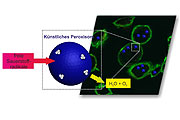Home > Press > Artificial organelles transform free radicals into water and oxygen
 |
| Inside the artificial peroxisome reactive oxygen radicals are being transformed into water (H2O) and oxygen (O2) via a reaction cascade with two enzymes. Adapted with permission from Tanner et al. Nano Letters 2013 13 (6), 2875-2883. Copyright 2013 American Chemical Society. |
Abstract:
Researchers at the University of Basel have successfully developed artificial organelles that are able to support the reduction of toxic oxygen compounds. This opens up new ways in the development of novel drugs that can influence pathological states directly inside the cell. The results have been published in the Journal «Nano Letters».
Artificial organelles transform free radicals into water and oxygen
Basel, Switzerland | Posted on July 16th, 2013Free oxygen radicals are produced either as metabolic byproduct, or through environmental influences such as UV-rays and smog. Is the concentration of free radicals inside the organism elevated to the point where the antioxidant defense mechanism is overwhelmed, the result can be oxidative stress, which is associated with numerous diseases such as cancer of arthritis.
The aggressive molecules are normally controlled by endogenous antioxidants. Within this process, organelles located inside the cell, so-called peroxisomes, play an important part, since they assist in regulating the concentration of free oxygen radicals.
Nanocapsules Transform Radicals into Water and Oxygen
Prof. Cornelia Palivan and her research group at the University of Basel have successfully produced artificial peroxisomes that mimic the natural organelle. The researchers developed a cell organelle based on polymeric nanocapsules, in which two types of enzymes are encapsulated. These enzymes are able to transform free oxygen radicals into water and oxygen.
In order to verify the functionality inside the cell, channel proteins were added to the artificial peroxisome's membrane, to serve as gates for substrates and products. The results show that the artificial peroxisomes are incorporated into the cell, where they then very efficiently support the natural peroxisomes in the detoxification process.
Novel Drugs
This type of effective principle targets the cell dysfunction directly on the cellular level, thus representing a further step towards the development of novel drugs that will make patient-oriented and personalized treatments possible in the future.
####
For more information, please click here
Contacts:
Reto Caluori
41-612-672-495
Prof. Cornelia G. Palivan
University of Basel
Departement of Chemistry
Tel. +41 61 267 38 39
University of Basel
Communications Office
Petersgraben 35, Postfach
4003 Basel
Switzerland
Tel. +41 61 267 30 17
Fax +41 61 267 30 13
Copyright © University of Basel
If you have a comment, please Contact us.Issuers of news releases, not 7th Wave, Inc. or Nanotechnology Now, are solely responsible for the accuracy of the content.
| Related Links |
| Related News Press |
News and information
![]() Researchers develop molecular qubits that communicate at telecom frequencies October 3rd, 2025
Researchers develop molecular qubits that communicate at telecom frequencies October 3rd, 2025
![]() Next-generation quantum communication October 3rd, 2025
Next-generation quantum communication October 3rd, 2025
![]() "Nanoreactor" cage uses visible light for catalytic and ultra-selective cross-cycloadditions October 3rd, 2025
"Nanoreactor" cage uses visible light for catalytic and ultra-selective cross-cycloadditions October 3rd, 2025
Nanomedicine
![]() New molecular technology targets tumors and simultaneously silences two ‘undruggable’ cancer genes August 8th, 2025
New molecular technology targets tumors and simultaneously silences two ‘undruggable’ cancer genes August 8th, 2025
![]() New imaging approach transforms study of bacterial biofilms August 8th, 2025
New imaging approach transforms study of bacterial biofilms August 8th, 2025
![]() Cambridge chemists discover simple way to build bigger molecules – one carbon at a time June 6th, 2025
Cambridge chemists discover simple way to build bigger molecules – one carbon at a time June 6th, 2025
![]() Electrifying results shed light on graphene foam as a potential material for lab grown cartilage June 6th, 2025
Electrifying results shed light on graphene foam as a potential material for lab grown cartilage June 6th, 2025
Discoveries
![]() Researchers develop molecular qubits that communicate at telecom frequencies October 3rd, 2025
Researchers develop molecular qubits that communicate at telecom frequencies October 3rd, 2025
![]() Next-generation quantum communication October 3rd, 2025
Next-generation quantum communication October 3rd, 2025
![]() "Nanoreactor" cage uses visible light for catalytic and ultra-selective cross-cycloadditions October 3rd, 2025
"Nanoreactor" cage uses visible light for catalytic and ultra-selective cross-cycloadditions October 3rd, 2025
Announcements
![]() Rice membrane extracts lithium from brines with greater speed, less waste October 3rd, 2025
Rice membrane extracts lithium from brines with greater speed, less waste October 3rd, 2025
![]() Researchers develop molecular qubits that communicate at telecom frequencies October 3rd, 2025
Researchers develop molecular qubits that communicate at telecom frequencies October 3rd, 2025
![]() Next-generation quantum communication October 3rd, 2025
Next-generation quantum communication October 3rd, 2025
![]() "Nanoreactor" cage uses visible light for catalytic and ultra-selective cross-cycloadditions October 3rd, 2025
"Nanoreactor" cage uses visible light for catalytic and ultra-selective cross-cycloadditions October 3rd, 2025
Interviews/Book Reviews/Essays/Reports/Podcasts/Journals/White papers/Posters
![]() Spinel-type sulfide semiconductors to operate the next-generation LEDs and solar cells For solar-cell absorbers and green-LED source October 3rd, 2025
Spinel-type sulfide semiconductors to operate the next-generation LEDs and solar cells For solar-cell absorbers and green-LED source October 3rd, 2025
![]() Rice membrane extracts lithium from brines with greater speed, less waste October 3rd, 2025
Rice membrane extracts lithium from brines with greater speed, less waste October 3rd, 2025
|
|
||
|
|
||
| The latest news from around the world, FREE | ||
|
|
||
|
|
||
| Premium Products | ||
|
|
||
|
Only the news you want to read!
Learn More |
||
|
|
||
|
Full-service, expert consulting
Learn More |
||
|
|
||








